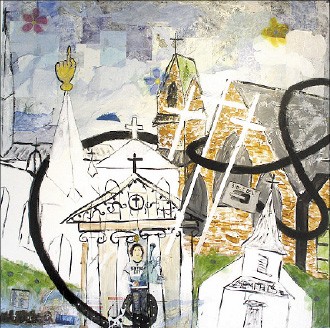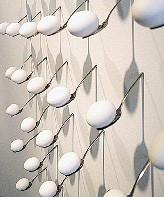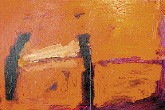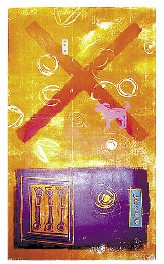During the month of April, the works of five widely read, widely traveled artists take us to faraway places and states of mind.
“New Work” by Gregory Burns at the Jay Etkin Gallery shorthands 40 years of travel in Asia. Swaths of color and calligraphic gestures bring to mind light filtering through chartreuse and magenta seas in Alila Lotus. Purple drips and emerald-greens wash down a hillside of rice paddies in Indonesia in Terraces II.

Burns’ Journey to Japan is one of the exhibition’s most evocative paintings. Two burgundy-black temple posts are set against a blazing red sunset inflected with pinks and corals. A swatch of light-yellow acrylic streams between and almost connects the two posts that bend toward one another. This is Japan’s philosophies — Buddhism and Shintoism — as well as its architecture and terrain. Here is a world where magenta mountain peaks rise suddenly from the bottom of the picture plane and door posts and skies look as radiantly alive as the holy men inside the temples.
Through April 28th
In his exploration of addiction, “Sometimes the Medicine Kills You” at the Material gallery, Ian Lemmonds is a master of allusion and illusion. For one work, he embeds 36 teaspoons in a wall. Each spoon casts a double shadow that looks like a pair of cutting shears. Thin lines of red thread run down the centers of the spoons’ handles, fall over their edges, and thread through long sewing needles. Like addiction, this ominous yet graceful work, capable of puncturing a vein or suturing a wound with stainless-steel precision, is mesmerizing.
In another surprisingly beautiful piece, Lemmonds takes 36 more spoons, turns them around, and embeds their handles in the wall. An egg rests in the bowl of each spoon. Arranged in rows of six at six-inch intervals, spoons and eggs cast multiple shadows that look like paddles swatting across the surface of the installation in slow motion. This work has the look, feel, and voice of addiction — “Here, take this (and this and this and this),” it seems to say. “Don’t stop. Don’t think. Swallow it whole.”

Through April 29th
Mother and son artists Sheri Fleck Rieth and Herb Rieth have put together the exhibition “Turn 2,” at On the Street Gallery. Sheri Rieth’s most successful works are large, garishly colored relief prints that darkly hint at the plight of others. A single creature — a barely discernible pink dog — stands in a lurid coral atmosphere next to a large crimson-red “X.” A rectangle, as purple-black as a bruise, fills the bottom third of the composition. Its size, shape, and surface resemble the freezers used to store the bodies of victims of Katrina. This end-of-the-line, the-buck-stops-here X is Rieth’s “in memoriam” to the environmental devastation and needless loss of life that occurred during the flooding of New Orleans.

Herb Rieth creates mixed-media paintings that are as socially aware, sardonic, and honest as his mother’s art. His alter-ego, “spaceman,” wears what looks like tin canisters and cowboy boots. Rather than “going where no one has dared to go before,” he is locked inside tin cans that protect him from the pollution in his own backyard.
Spaceman engages in a series of futile behaviors — projecting happy faces onto polluted clouds dripping with gunk (The Gift), playing banjo music for plants dying in denuded earth (Banjo), and continuing to shovel into the earth for fossil fuel (Aloha).

In Trojan, the bungling of this sad-sack begins to read like Greek tragedy. Still unable to change his behavior, spaceman drags a huge dinosaur on a circus wagon across a landscape covered with Iraqi desert camouflage and another pattern that can cloud one’s vision: fabric preprinted with American patriotic icons.
Through April 21st
Carol Buchman’s mixed-media paintings in her exhibit “Midrash: Stories Reclaimed” at Perry Nicole Fine Art also tell stories and search for meaning. In a particularly wry and expressive self-portrait, Bible Belt Bagel Babe, the artist stands between Ionic columns and under the pediment of a church designed to look like a Greek temple, one among many churches in the painting. Buchman wears a New York City T-shirt. Her right hand holds a bagel, her left holds a replica of the Statue of Liberty, and the statue, in turn, holds a copy of The Joys of Yiddish. A long black strap (the buckle reads “BIBLE BELT”) coils like a snake around Buchman, the churches, and the Statue of Liberty. A golden hand atop one of the church spires points to a sky layered with luminous blue and purple handmade paper. With humor and wisdom from many sources, this Bible Belt bagel babe weaves together an understanding of life and beyond.

Through April 28th